Flamingos are egg-cellent!
Easter is a time for renewal, rebirth and new life. Whether you celebrate the religious festival or simply the arrival of spring and (fingers crossed!) better weather, Eastertime is when everything seems to suddenly start growing, multiplying and breeding. In this spring-themed Flamingo Diary, we'll be looking at some egg-citing facts about flamingo nests, eggs and chicks. And we will discover why these amazing birds are such egg-ceptional parents!
Flamingos are unusual amongst birds in that they take a long time to grow up, they don't nest very often and when they do breed, they will produce a lot of young in one go. These are all adaptations to a very specialised way of life in some extreme and unpredictable habitats.
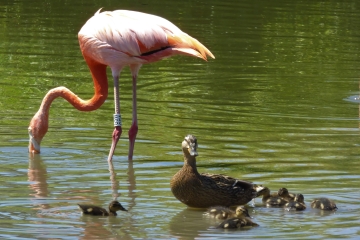
Unlike a more familiar bird like a mallard duck, which is fine tuned to nest when spring commences, wild flamingos can nest all year around. In the wild, these species breed in tune to the rains and when conditions are perfect for making nests and raising a youngster. When housed in animal collections in different parts of the world, flamingo will generally breed in the late spring and into summer, when weather conditions are warmest and most stable.
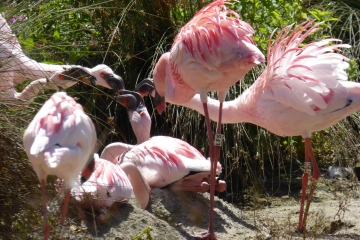
Flamingos can do their courtship dances and pick a partner many months before nesting. Because flamingos breed in an "all or nothing situation" to get as many birds in a flock to nest at the same time, they will wait for the most appropriate time for nesting and egg laying. So visitors to WWT centres might see flamingos dancing over Christmas and in January, for example, but not see any chicks until July.
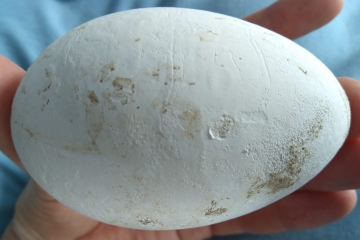
Flamingos lay a single, large, white egg. This has quite a thick shell and is covered in a chalky layer to protect the developing embryo and growing chick. This chalky layer is extra calcium deposits produced by the mother when the egg is laid. Flamingos nest in harsh environments, so having a tough egg covered in extra calcium ensures the valuable contents are not damaged by alkaline waters, toxic mud, or harsh weather.
You can see the chalky covering in the photo above, and check out the thickness of the eggshell in the photo below. Shining a light through the egg is called "candling" and this is a technique used to see if the egg is fertile and developing normally.
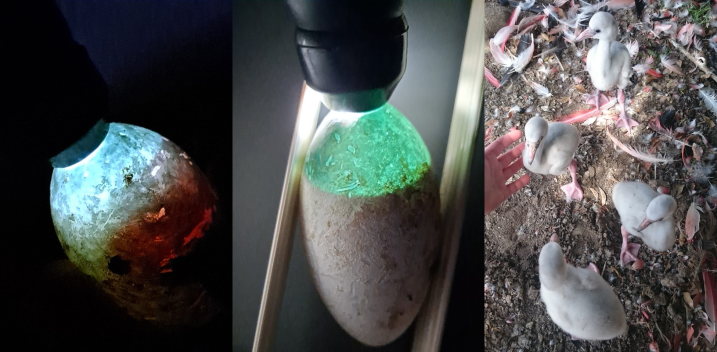
Eventually, this large, white chalky egg will produce a fluffy grey chick with a squidgy pink bill and legs.
Flamingo eggs are not pink. Wouldn't it be amazing if this were true though!? Unfortunately there is a fair amount of "fake news" out there that shows bring pink yolks pretending to be flamingo eggs. These are not real images, and they have been digitally created. Flamingo yolks are bright. They get stained by the same carotenoids that turn the flamingo's feather pink, and so they are an intense, deep orange. But they won't be a highlighter pink!
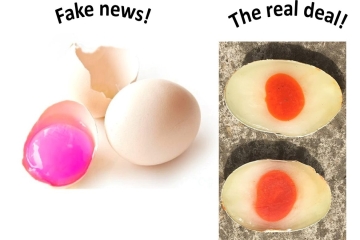
Flamingo eggs take a month (around 30 days) to hatch. They have specific temperature and humidity requirements to enable chick growth. In the wild, the parents will regulate temperature (by sitting on the egg to warm, or standing over to cool) and humidity (damp feathers from bathing create humidity) to the perfect degree. In captivity, if flamingos are incubating naturally they will do this temperature and humidity regulation in the same way, but if eggs are being incubated in an incubator, then the knowledge and expertise of animal care will ensure these parameters are met.
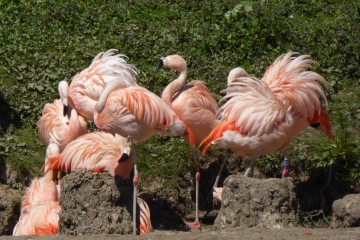
Flamingos are amazing engineers. They construct a nest out of mud and sand using their bill to cement small pellets together into a mound. This mound will grow as the bird incubates and can grow to over 30cm tall by the end of nesting (and sometimes bigger). The size of the nest mound keeps the chick dry from flooding, cool by catching the prevailing wind, and prevents over-heating by sucking in water at its base that evaporates at the top. Civil engineering to the max!
Both the flamingo mum and the flamingo dad will incubate the egg, look after and feed the chick. Once nesting is over and the chick is fledged, birds can wait for anything up to nine years before breeding again. But if you are a species that can nest in flocks of over one million birds (that's the lesser flamingo population in East Africa for you) and produce 500,000 chicks in one go, you really can afford to take your time and nest when everyone is ready. For flamingos, putting all of your eggs in one basket really can pay off!
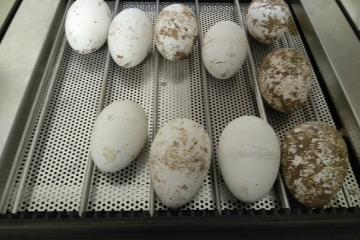
The flamingo eggs in the photo above are in an incubator and will be kept safe in the right conditions until they are due to hatch. They will then be given back to the parent birds who finish off the incubation and rear the chick. When a flamingo is ready to hatch, it will call loudly to its parent. The chick begins to "pip", which means break through the inner layer of the egg and out into the external world. You can see and hear this in the video below.
Happy Easter flamingo followers and I hope you get some time to spend checking what the flamingos are up to at your local WWT centre.



